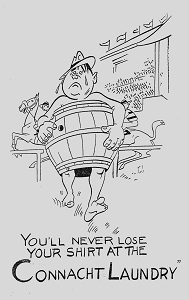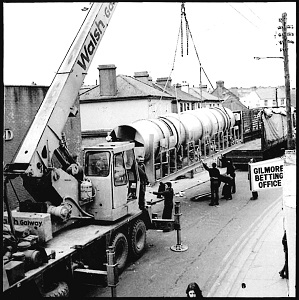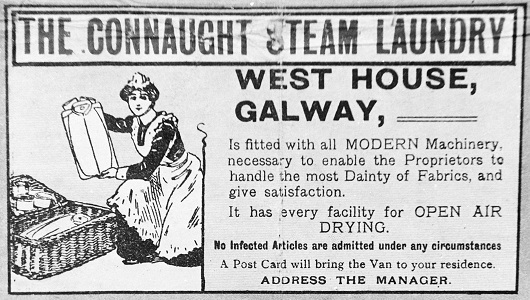THE CONNACHT LAUNDRY

by Tom Kenny
The very word laundry conjures up images of Dickensian workhouses, sweat shops, the smell of Sunlight soap, long working hours. It is no wonder some 1,500 laundresses went on strike in 1945 for the right to two weeks
In olden times, women washed clothes from a tub, In Galway, many of them would have done their washing from low sections of the river bank or the canal bank which would have provided flowing clean water. The oldest laundry we know of in Galway was the Magdalen Laundry in Forster Street which started up in 1824. In 1904, the Persse sisters started “The Connaught Steam Laundry” in Helen Street. They ran it until 1918 when they sold it to the Emerson sisters. They, in turn, sold the complex to Arthur Goodbody in 1920. It comprised the laundry equipped with modern plant, steam and electric power, three dwelling houses a garden and a builder’s yard. He changed the name to ‘The Connacht laundry’.
In the 1930’, they offered a ‘simplicity service’ – one price, two pence halfpenny per article washed, pressed and aired. The one exception to this was a heavy blanket or quilt which was counted as four articles with a minimum charge of 2/6. No starch was used in this service. Articles requiring starch were treated seperately. They also offered a dyeing and cleaning service. The phone number was Galway 124.

In July 1935, some trade unions took industrial action in protest at attacks on Catholics in Belfast. In Galway, this took the form of dockers refusing to unload a cargo of grain from the S.S. Comber, a ship owned by Sir William Kelly of Belfast. The A.T.G.W.U. went on unofficial strike and called on other workers to join them. Many of the women in the Connacht Laundry joined the strike even though they were not members of any union. Most of them were from ‘the west’ and related to dockers. The owners closed down the factory and the small number of men continued to work throughout. Despite the mediation of clergy, poloticians and union officials, the laundry remained closed with the result that the women sacrificed several week’s wages.
The company continued along traditional lines for almost four decades. It was ‘fully equipped with modern appliances, having a water supply of perfect softness and employing a capable and experienced staff of about sixty, and acquired a very good reputation for the quality of its work’. Initially, their deliveries were by horse and cart or bicycle, then they graduated to small gas-driven vans during the war. Later, they used charcoal-burning vans, then motorised vans and their fleet collected and delivered laundry from as far away as Kilkenny, Waterford and Clonmel. In 1958, it acquired the Dublin-based Court Laundry which gave it a broader representation countrywide.

In the late 1960’s, the traditional business – domestic laundry and dry cleaning – began to disappear with the advent of high street dry cleaners, washeterias and washing machines. Within a matter of years, some 50 laundries throughout the country had closed. The Connacht Laundry employed some 200 people and rationalised the business. They divested themselves of the Court Laundry, set up a towel rental company and expanded into the textile rental market. Next, they sold off the retail outlet in William St. which traded as Connacht Cleaners and Court Cleaners and also the Blue Line Cleaners in the Shopping Centre. Many people will remember their wonderful cinema adverts featuring Milo O’Shea waving his arm and leg while reflected in the window of the William St. shop.
The Goodbodys were always prepared to move with the times. In 1970, they set up the Linen Supply of Ireland. In 1981, a new company, Micron Clean was set up to service companies in the high technology area. The establishment of computer, electronics and pharmaceutical companies meant that ‘clean room’ garments had to be cleaned to an international standard, vacuum packed and delivered into special sterile lockers.
The company’s activities were now based on systems which involved the supply, cleaning and continuous management of a wide range of textile-based products. In 1996, the business was sold to an English company, CWSBOKO.
We have three illustrations for you today, the first an advert for the Connaught Steam Laundry dated 1920; the second, an advert during the Galway Races c1965 and the third, a photograph c1975 of a Schultess tunnel-washer in Helen Street. This massive machine, the only one of its type in Ireland was about to be lifted by crane into the laundry site and installed as part of the modernisation programme. This machine would wash one ton of linen every day.
